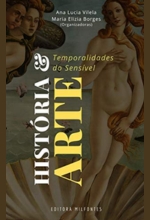Aesthetic historians – Review by Mileny Santos Xavier on the book “History and Art: temporalities of the sensitive”, organized by Ana Lúcia Vilela and Maria Elizia Borges

Abstract: History and Art: temporalities of the sensitive, explores the relationship between historiography and aesthetics. It is a collection organized by Ana Lúcia Vilela and Maria Elizia Borges that explores the cognitive and aesthetic experience of authors such as Ernst Kris, Eduard Fuchs, Aby Warburg, Georges Didi-Huberman, Glauber Rocha and Machado de Assis.
Keywords: Historiography, Aesthetics, Art.
The book History and Art: temporalities of the sensitive, published in 2019, addresses the dimension of the sensitive, since it is present in history; and poses its questions. These refer to the aesthetic character of writing or historical narrative — it marks the impossibility of being neutral — and the demand for new interpretations, in view of the objects of study that historians have come across. Thus, the texts that make up this work aimed to reflect on the temporality of objects that reach the academic and subjective field. This collection was organized by Professor Ana Lúcia Vilela, who holds a Master’s degree in Visual Arts and a PhD in History (in the Art, Media and Cultural Policies line), and Professor Maria Elizia Borges, who holds a Master’s degree in Social Sciences and a PhD in Arts.

The production of the copy was the result of a Colloquium, which took place at the Faculty of History of the Federal University of Goiás (UFG), with the title “What do historians do when they study art?”. And that had financial support from FAPED and CAPES, in addition to its subsidy, together with CNPq, to carry out the research. The collection is divided into nine chapters by different authors and, in general, into two large blocks that encompass all the texts. In the first, there are articles dedicated to theoretical and epistemological reflections on the subject and, in the second, the results of research that take artistic works as their object.
Based on the general division adopted by the book, the initial focus of this production turns to the first four chapters. In the case of the first essay, the author is Márcio Pizarro Noronha, who questions the work of Ernest Kris and the relationship between Art History and Psychoanalysis in the latter’s founding moments. Thus, the text continues carrying out and presenting investigations on the subject. In it, it is pointed out that, for there to be a dialogue between Psychoanalysis, History and Art History, it is necessary to take into account the differences that circulate between the areas, such as, for example, the sensorial and conceptual order between image and conceptualization process. The historian needs to broaden his approach.
The second is authored by Maria João Cantinho, with the title Eduard Fuchs: The art in the sails of Dialectical Materialism, which presents the figure of Fuchs in the light of Walter Benjamin, highlighting his attempt to understand the artistic object and the History of Art from the perspective of Historical Materialism. Thus, a new awareness of works of art is configured, in which they enter the historical-economic scenario. In the text by Maria Lúcia Kern, or the third chapter, the objective is to point out the interferences of paradigm shifts in the social and human sciences in the fields of knowledge of Visual Culture and Art History. In this sense, Kern promotes a historical outline of the areas through big names that participated in the process of remodeling this knowledge.
The last chapter, before the second block, is called: The disconcerting nudity of Venus: Botticelli, Aby Warburg and Georges Didi-Huberman and written by Daniela Campos and Maria Bernardete Flores. In general, this is Sandro Botticelli’s painting, “Venus”, through the analysis of two art historians: Aby Warburg and Georges Didi-Huberman. Both point to the attention to detail and the anachronism of the works. Once the first block is concluded, the authors direct the book towards the presentation of different historiographical approaches in order to understand art and the sensitive object.
Starting the discussions of the second block, Etienne Samain briefly presents seven books with the subtitle “the eye of history”. In addition, Samain raises several questions about Art and the History of Art and ends by pointing out that true art can open our eyes to the facts; she is eye and memory. With the name Migrações, Encontros e Misencontros: Contacts between South American Artists in Paris and London, Maria de Fátima Couto recovers the signs and records of the passage of artists, through Europe, linked to constructive/kinetic art and coming from South America. In this, she points out that there was no South American art or a homogeneous group, there were only artists trying to produce on the European continent.
In the case of Ana Lúcia Vilela, in the seventh chapter, there is a direction to cinematography, having as objects of analysis the films “Terra em Transe” and the Cinejornal owned by General Costa e Silva. Its objective was to unravel the relationship between the forms that involve filmic voices, the constitution and attribution of meaning that are directed to social bonds.
Trailer for Terra em Transe (1967), of Glauber Rocha | Image: YouTube
From a reading based on psychoanalysis, Vilela analyzes and draws conclusions from cinematographic productions. In the penultimate text, there is the contribution of the history of intellectuals to the study of the artistic field written by Clarice Lemos and Maria de Fátima Piazza, in which it is suggested to observe the reverberation or resonances of certain artists, or works within the artistic sphere. And this, based on reviews and/or articles published in journals.
Still dealing with this chapter, the authors discuss two intellectuals, Ricardo Bampi and Oswaldo Goeldi, and conclude that the study of scholars or artists contribute to the “rise” of the artistic field. Finally, the book ends with an essay by Raquel Campos, dealing with the history and literature of Machado de Assis. In this sense, the author briefly points out the history of studies on Machado and ends up highlighting Sidney Chalhoub, since he points out that “by telling the stories, Machado de Assis wrote and rewrote the history of Brazil in the 19th century” (Chalhoub apud p.239). However, in order to carry out this type of study, according to Campos, it is necessary to read literary reviews and dialogue with other texts.
With regard to the theme of the work, the variety and richness of aspects that are worked on throughout the book are noted, and a theoretical and practical perspective is presented. Thus, the objective of guiding historians in the study of the arts is achieved, or rather, in the contribution of this field to historiographical development. In this sense, there is also the organization of the texts, considering that they follow a logic that facilitates the development of the theme in the reader’s mind. Initially, it presents essays that deal with the theoretical scope, pointing out scholars and their respective ideas. Then, the methodological part is highlighted, that is, ways of how to proceed with different objects. With regard to the direct relationship between the chapters, the themes follow very different themes, taking into account that, for example, the contribution of the history of intellectuals in the study of art is addressed, after having dealt with cinema from the Dictatorship and the social bond.
However, as much as they are isolated texts, they manage to maintain the qualitative level and dialogue with each other, since, for example, the field of psychoanalysis is cited as a contributor and they present information that complements each other. An example of this is Vilela’s essay, as she mentions that psychoanalysis is a fundamental reading “key” for understanding human work and, consequently, in her case, films. This note of hers also fits into the branch selected by the other authors, since the other objects are also configured as human work and that they themselves recognize the contribution of the area, to the point that the first chapter of the book discusses the interfaces of the study between the history of art and psychoanalysis.
It is also important to mention that, in view of the chosen structure, the contents are not very in-depth, but that they present an overview that allows a general understanding and an incentive to further searches. In the last chapter, for example, it deals with the thesis that Machado’s literature promotes several contributions to History and, throughout the essay, Chalhoub’s work is discussed and the purpose of promoting an understanding and confirmation of the idea is reached, taking into account that examples are mentioned, directly and briefly, with the works of the realist author. With this, it mobilizes many historians within the theme and use of this type of source, thus showing its validity, given that literature, although it has elements of fiction, allows us to perceive elements of an era.
Another thesis, which is presented but not deepened, is the History of Art as an anachronistic exercise, in chapter four. In this, it is argued, based on a significant foundation, that “the life of the image is longer than human life” (p.104), that is, the time that surrounds it is immensely greater than the life, even of those who produced it. The image belongs to time and, in fact, it promotes, in the observer and scholar, an affectation, and the context in which they are inserted will say a lot about the look that is being promoted over the image. In this sense, the potential use of this thesis and this source is of great value for the study of History, when it seeks to focus on a new perspective, in order to reach a new version and perceive details that the official writing does not allow.
In conclusion, the work fully meets the theme that it proposes to discuss, which is to reflect on the temporality of objects that reach the intellect and the sensitive, and, for this, it begins by presenting the more theoretical and epistemological side, and continues by bringing examples of the use of artistic works as an object. That is, it builds the main foundations to help the scholar to address the topic. In this way, the book can be defined almost as a brief initiation “manual” for those interested in this axis. Regarding the indications of possible readers, their direction is more towards the academic public, due to concepts and approaches that focus on the presentation of the study itself.
Summary of História e Arte: temporalidades do sensível
- Apresentação
- 1. Ernst Kris, comentários críticos e irradiações da obra na contemporaneidade: um estudo de interfaces entre a história da arte e a psicanálise | Marcio Pizarro Noronha.
- 2. Eduard Fuchs: a arte nas velas do materialismo dialético | Maria João Cantinho.
- 3. Cultura visual, história da arte e paradigmas do conhecimento | Maria Lúcia Bastos Kern.
- 4. A nudez desconcertante de Vênus: Botticelli, Aby Warburg e Georges Didi-Huberman | Daniela Queiroz Campos & Maria Bernardete Ramos Flores
- 5. A arte enquanto olho e memória da história – Etienne Samain.
- 6. Migrações, encontros e desencontros: contatos entre artistas Sul-americanos em Paris e Londres (1950 – 1970) | Maria de Fátima Morethy Couto.
- 7. Ditadura e laço social: vozes e imagens em Terra em Transe e no Cinejornal da posse do General Costa e Silva | Ana Lucia Oliveira Vilela.
- 8. A contribuição da história dos intelectuais para o estudo do campo artístico | Clarice Caldini Lemos & Maria de Fátima Fontes Piazza.
- 9. Os historiadores e a literatura de Machado de Assis | Raquel Campos.
- Os autores
To broaden your literature review
- Consult book reviews on
- Arte | Arte Colonial | Arte Contemporânea | Arte Cubana | Arte Funerária | Arte Indígena | Arte Latino-Americana | Arte Makonde | Arte Medieval | Arte Pré-histórica | Arte Rupestre | Arte Sacra | Artes Visuais
- Crítica de arte | Crítico de Arte
- Ensino de Arte | Ensino de Artes | Ensino de Artes Cênicas | Ensino de História da Arte
- Função Social da Arte
- História da arte | Histórias da Arte
- Obra de arte
- Racialização da arte
- Consult dossiers of articles on
- Arte | Arte Abstrata | Arte africana | Arte Antiga | Arte Contemporânea | Arte Feminista | Artes | Artes Visuais
- Bienais de Arte
- Circuitos de Arte
- Conceito de Arte
- Exposições de Arte
- História da Arte
- História Social da Arte
- Historiografia das Artes
- História das Artes
- Mundo das Artes
About the reviewer
 Graduating in History from the Universidade Federal de Sergipe and Scientific Initiation Scholarship within the scope of the project “For a Poetics of the Sertões: History, art and photography in the work of Otoniel Fernandes Neto”, under the guidance of prof. Antonio Fernando Sa (UFS). ID LATTES: http://lattes.cnpq.br/9741770400720152; ID ORCID: https://orcid.org/0000-0001-7248-9974; E-mail: milenyxavier6@gmail.com.
Graduating in History from the Universidade Federal de Sergipe and Scientific Initiation Scholarship within the scope of the project “For a Poetics of the Sertões: History, art and photography in the work of Otoniel Fernandes Neto”, under the guidance of prof. Antonio Fernando Sa (UFS). ID LATTES: http://lattes.cnpq.br/9741770400720152; ID ORCID: https://orcid.org/0000-0001-7248-9974; E-mail: milenyxavier6@gmail.com.
To cite this review
VILELA, Ana Lúcia; BORGES, Maria Elizia (org.). História e Arte: temporalidades do sensível. Vitória: Editora Milfontes, 2019. 266p. Review of: XAVIER, Mileny Santos. Aesthetic historians. Crítica Historiográfica. Natal, v.3, n.11, May/June, 2023. Available in<https://www.criticahistoriografica.com.br/en/historians-studying-art-review-by-mileny-santos-xavier-on-the-book-history-and-art-temporalities-of-the-sensitive-organized-by-ana-lucia-vilela-and-maria-elizia-borges/>. Doi:
© – The authors who publish in Crítica Historiográfica agree to the distribution, remixing, adaptation and creation of their texts, even for commercial purposes, provided that due credit is guaranteed for the original creations. (CC BY-SA).








